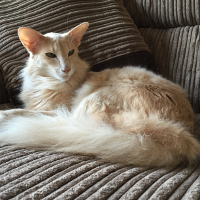|
A brief historical overview
|
The history of the Mandarin begins with that of the Oriental. In fact, the Mandarin is a semi-long-haired variety of the Oriental, descended directly from the Siamese.
It was the English who brought the Siamese back from Thailand, along with other cats with identical physiques but different colorpoints. Legend has it that they were sacred cats in Thailand, or that they were bred by the King of Siam. Arriving in Great Britain at the end of the 19th century, the Siamese, much more exotic and original than the Oriental, was an immediate success, while its non-pointed cousin fell into oblivion.
It was only after the Second World War, when purebred cat breeding was at its lowest ebb, that breeders resorted to numerous crosses to revive or create certain breeds. This was the case with the Oriental, a cross between Siamese, Abyssinian, British Shorthair, Russian Blue and Alley Cat. The result was a cat with an oriental type, linked to the origins of the Siamese but not pointed. It was named foreign shorthair.
In the 1970s, Oriental cats were imported to the United States, where Siamese and American shorthair were crossed to introduce new colors. The result was a Havana brown cat, but this breed evolved differently and is now registered as Havana brown.
In the 1980s, Orientals and Balinais were crossed to produce a semi-long-haired Oriental. This variety was recognized as a breed in its own right under the name Oriental longhair for the CFA in 1994 and for the TICA in 1998. In Europe, they are known as Mandarins or sometimes Javanese. The breed is still rare in France, where the LOOF registers fewer than 20 births a year. In 2008, the Mandarin represented just 0.07% of all pedigree cats in France. The GCCF registers around 50 Mandarin births a year, out of a total of 30,000 new kittens registered each year. |
General appearance
|
The Mandarin's silhouette is long and supple. They are medium-sized, with fine bones and firm muscles. It should exude elegance. A body that is too short or massive is considered a fault by the judges. Hips and shoulders should be of equal width.
The French standard specifies that the Mandarin, although fine, must not be too thin. |
Behavior / characteristics
|
| The Mandarin's character is the same as that of the Oriental, i.e. talkative, lively, playful and very attached to its owner. Of course, character is above all individual and depends on the history of each individual, whatever the breed. |
Health
|
Breeds derived from the Siamese, such as the Mandarin, are affected by amyloidosis. This disease leads to liver damage, resulting in chronic renal failure and eventual death. The disease has only recently been discovered in cats, and no genetic studies have yet been carried out to determine how it is transmitted. An analysis of pedigrees shows, however, that it could be hereditary.
Symptoms include diarrhoea, which may be accompanied by lethargy and refusal to eat. There is no treatment for the disease, only its symptoms. This consists of anti-inflammatory treatments and drugs to slow the progression of renal failure. A blood transfusion may be required in the event of anemia. However, affected cats die before the age of 5, at an average age of 3½ years, although a sick cat may reach the age of 11. At present, veterinarians recommend an autopsy of all Siamese and related cats that die unexplained deaths in order to better understand the disease. |
|







 English (United Kingdom)
English (United Kingdom)